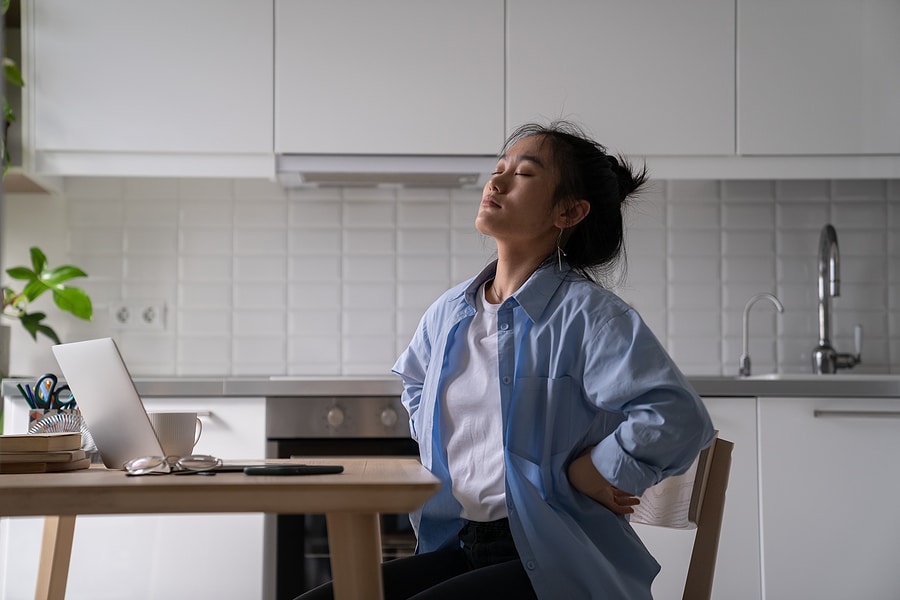In today’s digital age, where hours are spent glued to screens and desks, the significance of sitting comfortably and maintaining proper posture often goes unnoticed!
However, these aspects play a pivotal role in our overall well-being, especially for students, employers, office workers, and the rest who spend a considerable portion of their day seated.
This blog post sheds light on the importance of sitting comfortably and maintaining good posture, supported by a few statistics, and also offers practical tips to make a difference.
The impact of poor posture
Poor posture is not merely an aesthetic concern; it can have serious consequences for our physical health and mental well-being.
Here are some eye-opening statistics that highlight the negative effects of improper posture:
- Back pain – According to the American Chiropractic Association, back pain is a leading cause of missed workdays and is the single leading cause of disability globally. An estimated 80% of people will experience back pain at some point in their lives, often exacerbated by poor posture.
- Screen time – A study published in the journal ‘Ergonomics’ found that university students spend an average of 6.5 hours daily using electronic devices, leading to a significant increase in musculoskeletal symptoms, including neck and shoulder pain.
- Confidence – The Cleveland Clinic reports that good posture can have a positive effect on self-esteem and overall confidence. On the other hand, slouching can lead to feelings of insecurity and reduced self-assuredness.
- Spinal alignment – Research published in the journal ‘Clinical Biomechanics’ reveals that sitting with a 90-degree angle between the thighs and the lower body is not ideal for spinal health. Instead, an open angle of 135 degrees or more can alleviate pressure on spinal discs and reduce the risk of spinal issues.
Practical tips for improved comfort and posture
- Ergonomic seating – Invest in an ergonomic chair that provides proper lumbar support and can be adjusted to suit your body’s needs. This is especially crucial for students and office workers who spend long hours sitting.
- Monitor and eye level – Position your computer monitor at eye level to avoid straining your neck and shoulders. This simple adjustment encourages better posture and reduces discomfort.
- Break time – The Pomodoro Technique, which involves working for 25 minutes and then taking a 5-minute break, can help alleviate strain on your body and eyes. During breaks, stand, stretch, and move around to prevent stiffness.
- Desk organisation – Arrange your workspace to minimize unnecessary reaches and strains. Keep frequently used items within easy reach to avoid twisting and straining your body.
- Mindful awareness – Regularly check your posture throughout the day. Set reminders to sit up straight and adjust your position if needed.
- Stretching routine – Incorporate simple stretching exercises into your daily routine to promote flexibility and relieve muscle tension. Focus on stretching your neck, shoulders, and back.
- Exercise regularly – Engage in physical activities that strengthen your core muscles, which play a vital role in supporting your spine and maintaining good posture.
Make a start today
Sitting comfortably and maintaining proper posture are vital aspects of overall health and well-being, especially if you’re a student.
Studying a distance-learning course involves a decent portion of your time seated, in front of a screen, so we really felt that this is an important topic to cover as a training provider.
Whether you’re at the office, using your local library, or studying from home, every situation requires some caution.
The statistics speak for themselves, underlining the far-reaching effects of poor posture on physical health, self-esteem, and productivity.
By implementing the practical tips provided in this article, you can take proactive steps to improve your comfort and posture, ultimately leading to a healthier, more confident, and productive lifestyle – both at home and work!
Remember, a small effort each day can amount to big results, give it a go or you’ll never know.
If you are experiencing prolonged posture related issues, do please visit your doctor. If you are experiencing these problems in your workplace, you should make the appropriate arrangements with your employer for a Workplace Fitness Review.
Disclaimer: We are not doctors or experts, so please do go to the HSE website for more information – Good posture when using display screen equipment – MSD – HSE
Ready to enrol?
Click here: Shop – Accountancy Learning
For any other questions, please get in touch with us, we are always happy to help.
Call us: 01392 435349
Email us: [email protected]
Message us: Facebook




